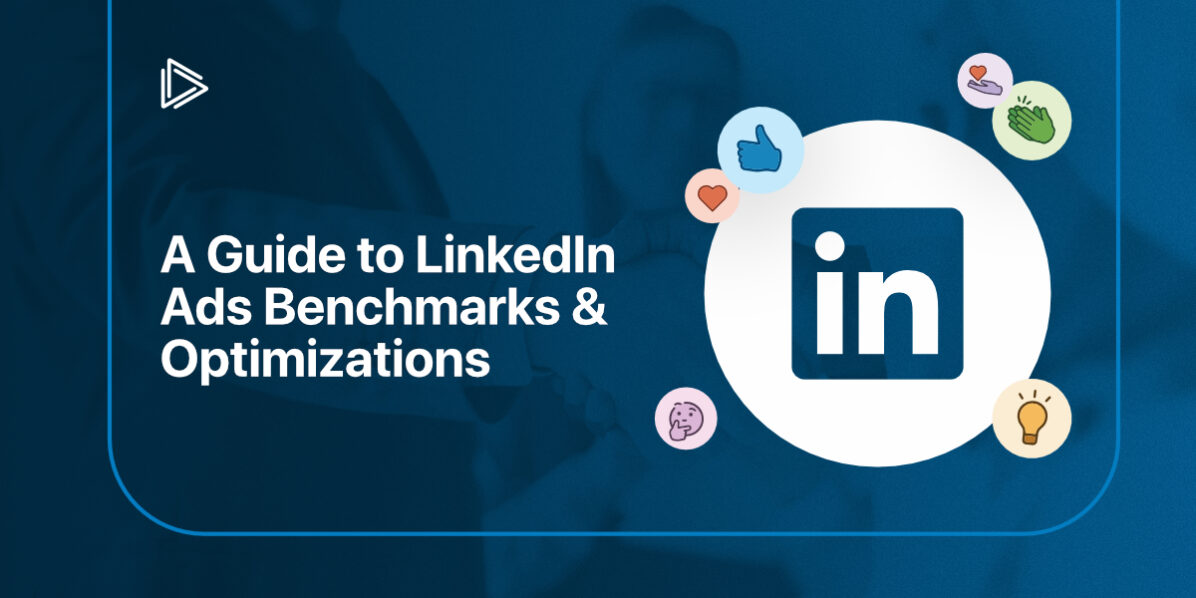Keeping up with the ever-changing digital marketing landscape can be time-consuming and stressful. It’s easy to search for the latest social media advertising tips, but many times readers aren’t looking for general knowledge. They simply want to know if their campaigns are performing and if not, how to turn things around for the better.
LinkedIn is fine-tuned for professionals and businesses. When compared to other popular social media channels like Facebook, Instagram, and TikTok, it can appear overly buttoned-up and corporate. This is not a fault – instead, it’s geared so the users’ mindset turns towards their professional industry and their own career, putting them in prime position to consider offers from B2B’s (and some B2C’s) looking to sell products and services.
Just like other social media channels, LinkedIn continues to update its ad platform to stay innovative. In this blog post, we’re covering the need-to-know points every LinkedIn marketer should reference for optimized ad performance.
LinkedIn Ad Types
Before we dive into optimal KPI benchmarks, it’s important to review what ad types are currently available on LinkedIn. Each one has its own pros and cons, so considering these are essential to creating strong campaigns.
Sponsored Content
Sponsored Content ads are created to look like organic content in your audience’s news feed. They may contain text with a single image (Single Image Ads), text with a video (Video Ads), or text with multiple images in a set order (Carousel Ads).
These ads are highly effective because of their organic appearance that fit seamlessly into a user’s news feed, helping to support a high-quality user experience while still getting your message across.
Sponsored Content ads are a great starting point for building top-of-funnel awareness. We recommend them for awareness and consideration campaigns, especially if you are new to LinkedIn Ads and not sure which ad format to start with.
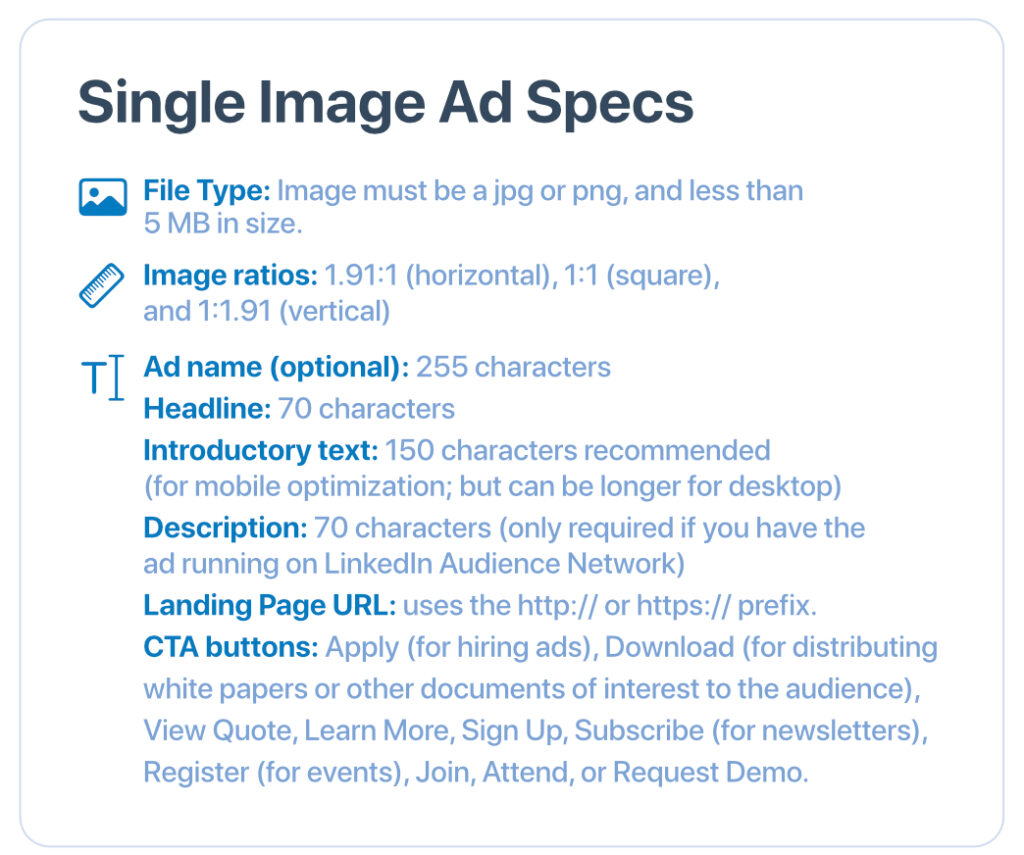
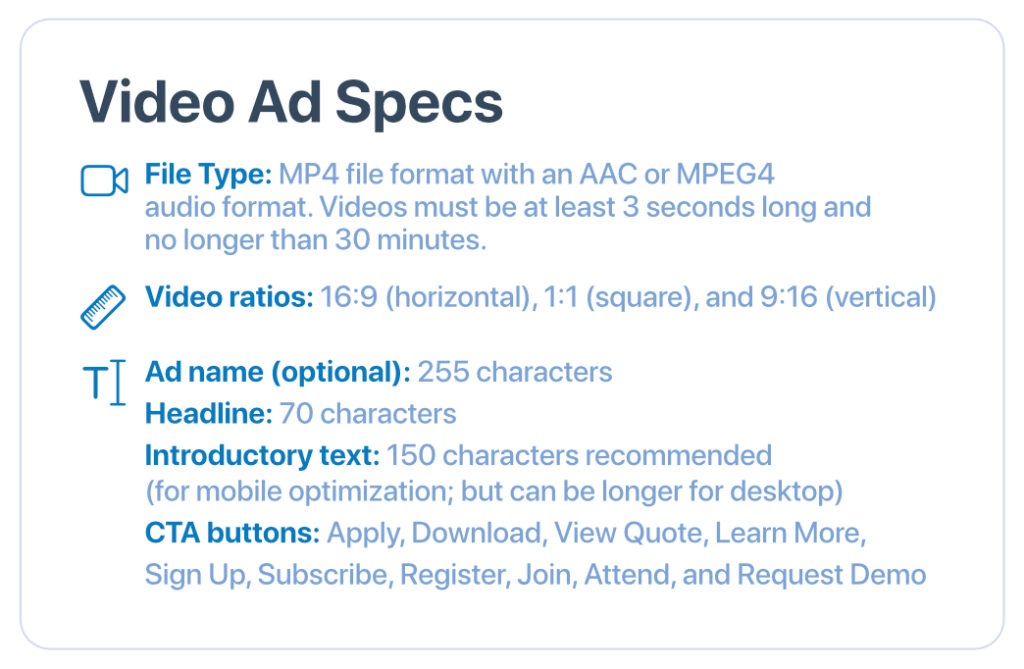
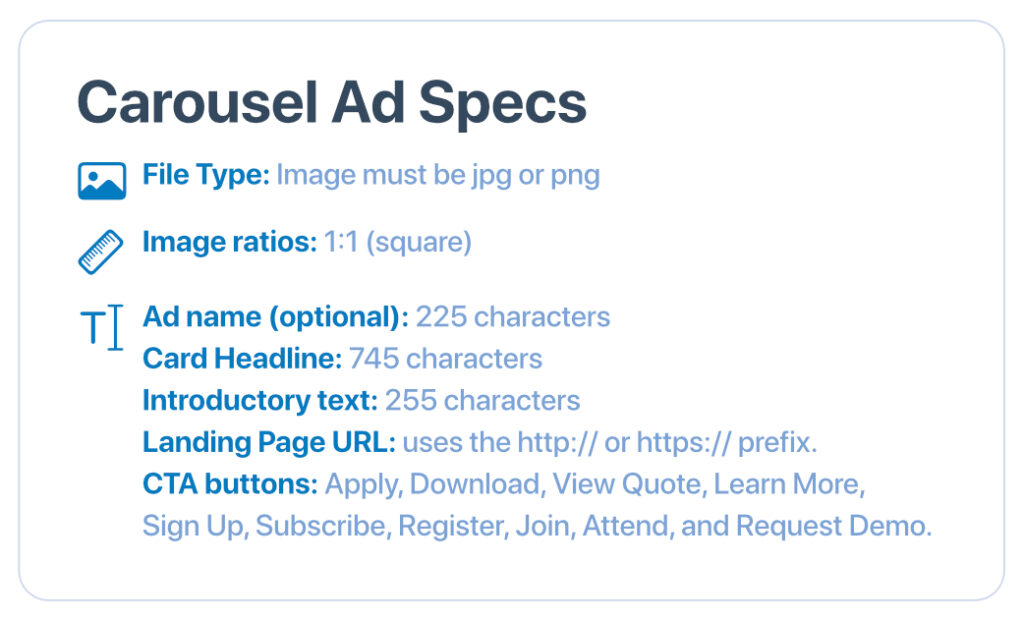
Conversation Ads
Using messaging in your marketing campaigns is a fantastic way to create more intimate communication about your products and/or services while targeting those users who are further down the conversion funnel.
LinkedIn offers two options for Sponsored Messaging: Conversation Ads and Message Ads. Conversation Ads send messages through LinkedIn’s chat feature, offering multiple call-to-action buttons in the message so that users can access the information they want with little effort.
Message Ads are designed to be targeted messages sent through LinkedIn’s chat feature that look and feel natural without call-to-action buttons. The biggest difference between these ads and organic messaging is that Conversation Ads allow you to message contacts you are not connected with and distributes the message to these contacts on your behalf.

Lead Gen Forms
When your business is looking to collect more direct leads, Lead Gen Forms are a great way to get them. It makes filling out a lead gen form super easy for users by auto-filling certain fields using information from a user’s LinkedIn profile. We recommend using Lead Gen Forms on audiences that are “warm” – those who are familiar with your brand, your offerings, and are likely ready to convert.
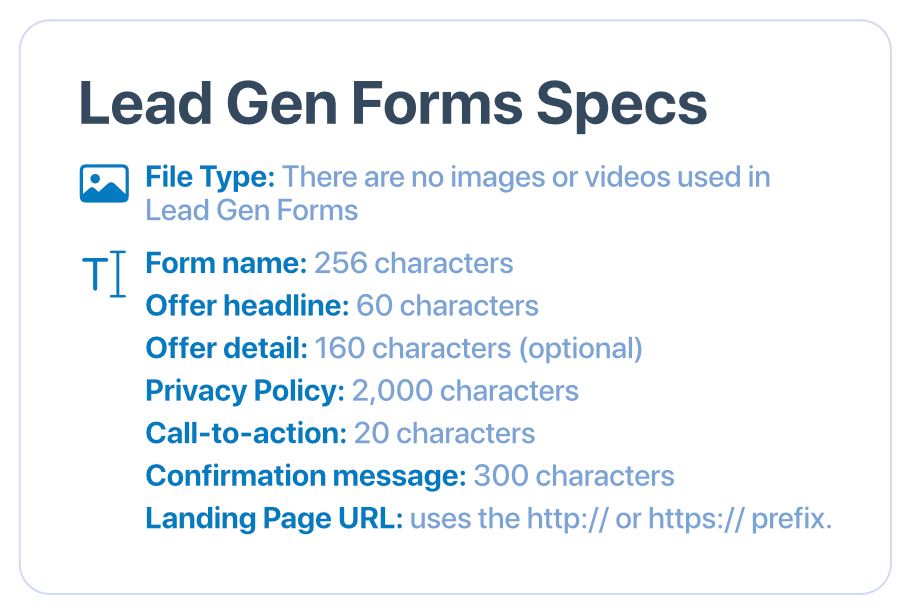
There are a variety of form fields to select from. The less fields you can include, the better, making the process short and straightforward for the user.
- At minimum, include at least 3 fields.
- The maximum number of fields you can include is 12
- Form fields you may include: First name, Last name, Email address, LinkedIn profile URL, Phone number, City, State/Province, Country/Region, Postal/Zip code, Work email, Work phone number, Job title, Function, Seniority, Company name, Company size, Education degree Field of study, University/School, State date, Graduation date, and Gender.
- There are a maximum of three custom questions you can ask. These are optional. Each custom question has a 100 character limit.
Text and Dynamic Ads
These ads are like PPC ads, except housed on the LinkedIn platform. Text Ads are the most similar, while Dynamic Ads, otherwise known as Spotlight Ads, allow personalization. Follower Ads also fall under this category. These are text ads that call the audience to follow your company page. You can set PPC or CPM caps to control budgets and choose whether to pay for clicks or impressions. We recommend these ads for top-funnel campaigns to build awareness of your brand, especially when trying to gain more organic followers to your company page. However, these ads are not as front-and-center on the channel as other LinkedIn ad types and are not recommended for bottom-funnel or conversion campaigns.
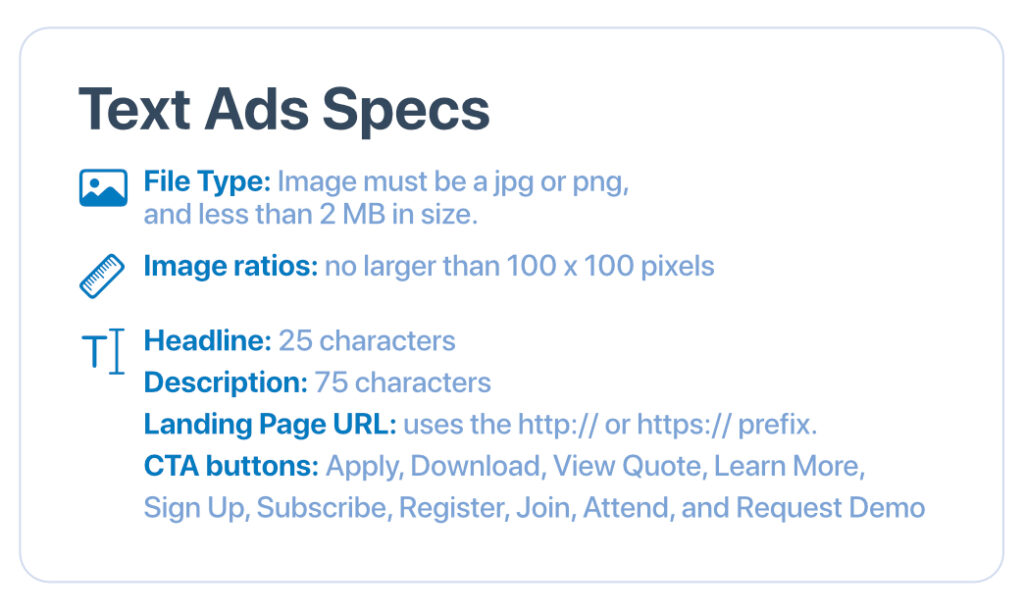
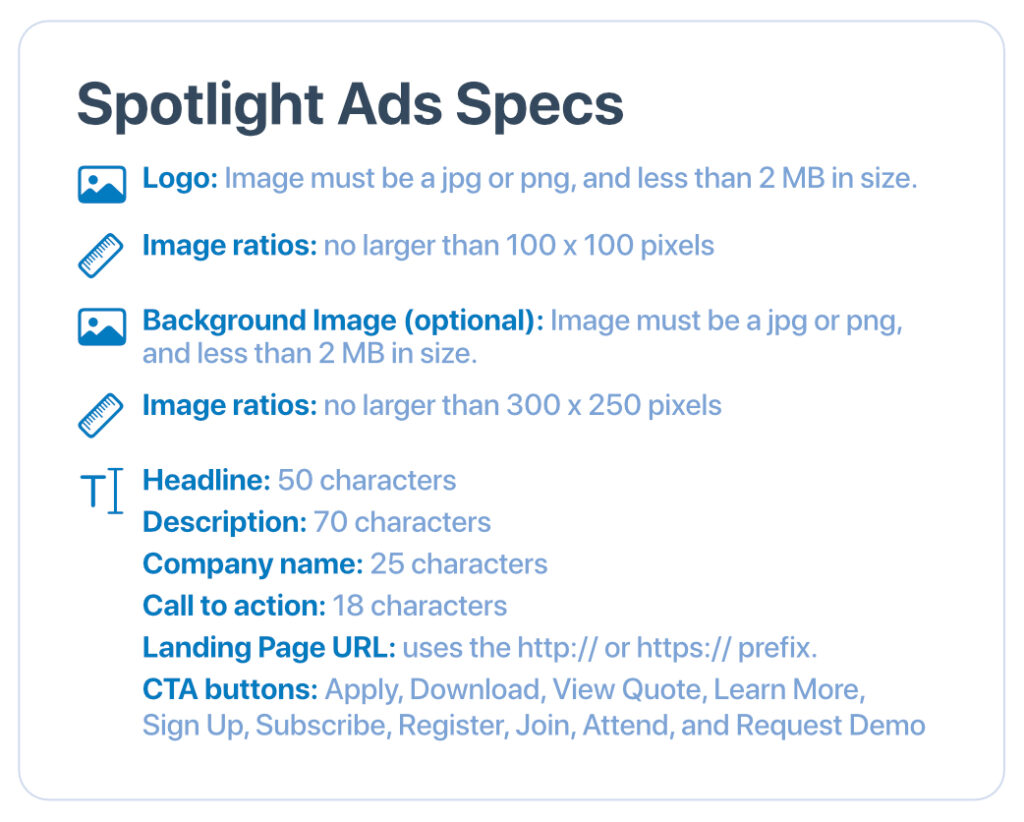
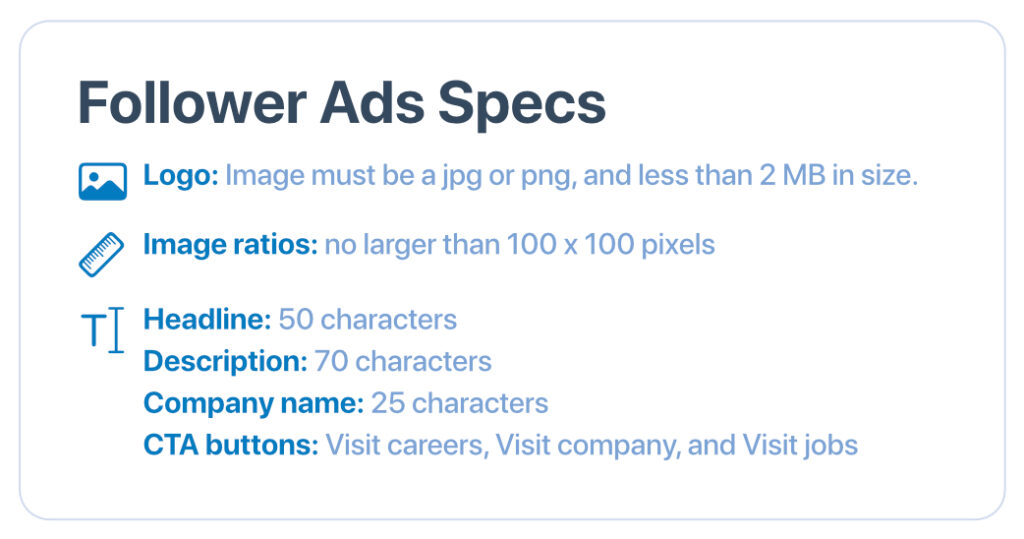
These ads give you a fixed set of headlines and descriptions to choose from. This allows LinkedIn to personalize the copy to the user. Check out the available options here.
LinkedIn Ad Benchmarks
Ideally, LinkedIn would report ad benchmarks from all LinkedIn data on their platform, but they do not offer this. Therefore, other third-parties have published the benchmarks from data across all the LinkedIn ad campaigns they oversee. Using a sampling of these published benchmarks, plus our own historical data, we’ve developed our own list for you to use as comparison to your own campaigns.
Three things are important to keep in mind when referencing our LinkedIn ads benchmarks:
- These metrics may vary depending on demographics of your audience like industry, seniority, geographic location, etc.
- The COVID-19 pandemic drastically changed behaviors at the beginning of 2020. While it is expected that metrics will normalize throughout 2021, historical data from 2020 may be considered outliers to typical performance. We’ve tried to minimize using those numbers while creating these benchmarks.
- It’s always a good idea to maintain your own list of benchmarks using historical data from your own campaigns. What’s “normal” for one business may never fall within reach of another, but that doesn’t mean the campaign wasn’t successful. Ultimately, seeing a return on ad spend or reaching marketing goals through your campaigns are the truest markers of success.
With that being said, let’s look at current 2021 LinkedIn ad benchmarks for three major metrics:
- Click Through Rate (CTR): 0.27%
- Cost Per Thousand (CPM): $7.14
- Cost Per Click (CPC): $4.20
5 Ways to Optimize Your LinkedIn Ad Campaigns
Knowing about all the ad options and a few 2021 benchmarks for LinkedIn ads, how do we ensure our own campaigns perform their best? We’ve compiled a few of our most successful tips and tricks to share with you.
1. Choose the right ad type for your campaign objective: It’s easy to get excited about utilizing a specific ad type when building your campaigns but making sure all aspects of the campaign align with your overall objective is crucial. For those not familiar with campaign objectives, LinkedIn offers the following:
Awareness: This is the top of the conversion funnel. Typically, top funnel campaigns are designed to create brand awareness. This includes prospecting through Lookalike audiences based on previous converters or developing new core audiences targeting specific demographics and business traits. Your goal here is not to convert or gain leads right away, but instead to “warm” a “cold” audience that is likely to be unfamiliar with your brand, products, and/or services.
Ad Types Optimized for Awareness Campaigns: Sponsored Content, Text & Dynamic Ads
Consideration: The middle of the funnel, where Consideration lies, is a turning point for many in your audience. This is where they decide whether to pursue more information about your business and what you offer. When running a Consideration campaign, LinkedIn gives you three objectives to choose from: Website visits, Engagement, and Video views. Here, you’d want to target audiences created from previous website visitors or those who have engaged with your top-funnel campaigns. This is not the place to teach a “cold” audience about your brand.
Ad Types Optimized for Consideration Campaigns: Sponsored Content (especially Video and Carousel Ads), Conversation Ads, Spotlight Ads
Conversions: The bottom of your funnel is for conversions and re-engagement with current and previous clients. You should be serving ads to those serious about buying products or services from your company, or job applicants wanting to apply. Retargeting audiences are ideal to engage with.
Ad Types Optimized for Conversions Campaigns: Lead Gen Forms, Conversation Ads
2. Keep copy short and sweet: As you can imagine, many engaged on LinkedIn are also busy. On top of that, the digital age has influenced attention spans, especially when using mobile devices. Reading your ads shouldn’t be a chore. You want to convey your message and call to action swiftly while still making an impact. As a recommendation, try to limit each part of copy in your ads to 150 characters or less (unless there is a shorter character limit, obviously). Your copy should also draw the audience in and be appropriate for accomplishing the campaign objective.
3. Don’t Discount Emojis: These tiny but powerful images share a lot of meaning in one character. While emojis may seem too casual for ads targeted at professionals, their use has permeated almost every facet of modern communication – including the business world. Just remember to use them sparingly and don’t go overboard.
4. Don’t be afraid of getting creative – with your creative: Just because LinkedIn is a professional social media channel doesn’t mean your ads must be dry and static. Many of the creative optimizations used in channels like Facebook and Instagram can be applied here with similar results – just make sure, like always, your creative is effectively communicating your brand and your message.
Some ways to optimize your creative include:
Video: Short videos and gifs are eye-catching and grab your audience’s attention. When using these assets, make sure to include branding if you are trying to raise brand awareness. And if your video features audio dialogue, add captions so that mobile users with silent phones can still engage. Use gifs to give life to what would normally be static creative – even if it’s just adding a bit of motion or change of color.
Static Images: One picture can truly communicate a lot – Don’t be tempted to add a lot of text to your graphics. It muddies up the creative and turns off the audience. While LinkedIn won’t penalize ads using excessive text in the graphics, it still creates a poor performing ad.
5. LinkedIn Ads Aren’t Just for B2B – Believe it or not, some B2C brands may also benefit from LinkedIn Ads. This is especially true after the pandemic sent office workers home to carry out their jobs – Google Trends shows a major spike in searches for “home office” in March 2020, and search volume for this key phrase continues to be high. Therefore, users have home office furniture and supplies on the mind, and ecommerce brands selling these items would greatly benefit from ads on LinkedIn. Some other products and services that may benefit include blue-light filtering glasses, benefit providers for self-employed individuals, financial advisors, productivity or organization applications, and universities offering post-graduate education.
We hope this guide will give you confidence in starting to build your own LinkedIn campaigns. Feel free to bookmark this blog to reference in the future when you most need it.
Looking for more help, or a customized solution to LinkedIn Ads? Ad Parlor is well-equipped to create successful paid media campaigns across LinkedIn and other social media channels. Send us a note and we’ll be in touch.
